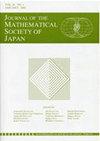On the energy of quasiconformal mappings and pseudoholomorphic curves in complex projective spaces
IF 0.7
4区 数学
Q2 MATHEMATICS
引用次数: 0
Abstract
We prove that the energy density of uniformly continuous, quasiconformal mappings, omitting two points in CP, is equal to zero. We also prove the sharpness of this result, constructing a family of uniformly continuous, quasiconformal mappings, whose areas grow asymptotically quadratically. Finally, we prove that the energy density of pseudoholomorphic Brody curves, omitting three “complex lines” in general position in CP, is equal to zero. According to the Picard Theorem, a holomorphic function f defined on the complex plane C is constant as soon as f(C) omits at least three values in CP1. This result has different generalizations in at least two directions. S.Rickman [11] proved that for every n ≥ 2 and for every K > 1, a nonconstant entire Kquasiregular mapping in Rn omits at most m = m(n,K) values. M.Green [6] proved that a holomorphic map from C to the complex projective space CPn, omitting (2n+ 1) hyperplanes in general position, is constant. An almost complex version of that result was proved by J.Duval [5] for entire pseudoholomorphic curves in the complement of five J-lines, in general position in CP2 endowed with an almost complex structure J tamed by the Fubini Study metric ωFS . Let f be a mapping defined on C with values in CPn, f ∈ W 1,2 loc (C). We recall that if D ⊂⊂ C, then Area(f(D)) := ∫ D f ωFS is the area of f(D), counted with multiplicity. Then, the energy density E(f) defined by E(f) = lim sup R→∞ 1 πR2 Area(f(DR)) = lim sup R→∞ 1 πR2 ∫复射影空间中拟共形映射和拟全纯曲线的能量
我们证明了在CP中省略两点的一致连续拟共形映射的能量密度等于零。我们还证明了这个结果的尖锐性,构造了一个一致连续的拟共形映射族,其面积渐近二次增长。最后,我们证明了伪全纯Brody曲线的能量密度等于零,在CP中的一般位置省略了三条“复线”。根据Picard定理,只要f(C)在CP1中省略了至少三个值,则在复平面C上定义的全纯函数f就是常数。这个结果至少在两个方向上有不同的概括。S.Rickman[11]证明了对于每n≥2和每K>1,Rn中的一个非恒定整体K拟正则映射最多省略m=m(n,K)值。M.Green[6]证明了从C到复投影空间CPn的全纯映射,在一般位置省略(2n+1)个超平面,是常数。J.Duval[5]证明了该结果的一个几乎复杂的版本,适用于五条J线的补码中的整个伪全纯曲线,在CP2中的一般位置,赋予了Fubini研究度量ωFS所驯服的几乎复杂的结构J。设f是在C上定义的映射,其值为CPn,f∈W 1,2-loc(C)。我们记得,如果D⊂⊁C,那么面积(f(D)):=ŞD fωFS是f(D的面积,用多重数计数。然后,由E(f)=limsupR定义的能量密度E(f→∞ 1πR2面积(f(DR))=lim-sup R→∞ 1πR2Ş
本文章由计算机程序翻译,如有差异,请以英文原文为准。
求助全文
约1分钟内获得全文
求助全文
来源期刊
CiteScore
1.40
自引率
0.00%
发文量
56
审稿时长
>12 weeks
期刊介绍:
The Journal of the Mathematical Society of Japan (JMSJ) was founded in 1948 and is published quarterly by the Mathematical Society of Japan (MSJ). It covers a wide range of pure mathematics. To maintain high standards, research articles in the journal are selected by the editorial board with the aid of distinguished international referees. Electronic access to the articles is offered through Project Euclid and J-STAGE. We provide free access to back issues three years after publication (available also at Online Index).

 求助内容:
求助内容: 应助结果提醒方式:
应助结果提醒方式:


